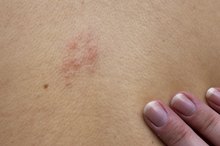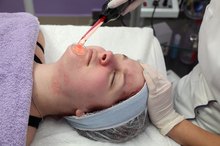Chemical Peels for Scars
Scarring can develop for a number of reasons, including injury and acne. Many consider scarring, especially on the face, unsightly and seek ways to remove it. Depending on the depth of the scar, treatment options vary. Dermatologists offer chemical peels as one option, especially for scars close to the surface of the skin.
How Chemical Peels Work
A chemical peel is a relatively safe procedure whereby a chemical is applied to the skin. When the chemical is peeled away, the top layer of the skin is removed, revealing skin that is healthier, more vibrant and smoother. This procedure is used to treat a number of skin conditions, including acne, wrinkles, dark spots, sagging and scarring.
Types of Peels
Glycolic Acid & Keloids
Learn More
There are four main types of chemical peels, and the difference is the kind of chemical used. Alpha hydroxy acid is the mildest of the treatments. Glycolic acid is used primarily on skin with sun damage. Trichloroacetic acid is usually recommended for those with darker skin. Phenol is the strongest solution used in chemical peels.
- There are four main types of chemical peels, and the difference is the kind of chemical used.
- Glycolic acid is used primarily on skin with sun damage.
Effectiveness of Peels
A chemical peel removes the top layer of skin, exposing the layer below. If a scar is close to the surface of the skin, the peel will remove the layer that has the scar. Most scars, however, are deeper. For those scars, chemical peels can be done in phases, with as many as six in a certain period of time. Many people report a significant improvement in their appearance.
- A chemical peel removes the top layer of skin, exposing the layer below.
- If a scar is close to the surface of the skin, the peel will remove the layer that has the scar.
Side Effects
Side Effects of a Chemical Face Peel
Learn More
Most consider a chemical peel a relatively safe procedure. But a peel can have side effects, according to the University of Maryland Medical Center 1. Certain kinds of skin may experience a slight change in tone, and this can be temporary or permanent. Occasionally scarring may occur, which is usually treatable. Recovery time for a chemical peel treatment takes anywhere from four to 10 days depending on the type of peel used and the depth of the peel.
- Most consider a chemical peel a relatively safe procedure.
- But a peel can have side effects, according to the University of Maryland Medical Center 1.
Skin Care After a Chemical Peel
A dermatologist will provide specific care instructions after a chemical peel. Generally, you should avoid exposure to the sun for a time.
Related Articles
References
- University of Maryland Medical Center: Plastic Surgery Chemical Peels
- Kaiser Permanente Cosmetic Services: Chemical Peels
- American Academy of Dermatology: Chemical Peels
- American Society of Plastic Surgeons: Chemical Peel
- O'connor AA, Lowe PM, Shumack S, Lim AC. Chemical peels: a review of current practice. Australas J Dermatol. 2018;59(3):171-181. doi:10.1111/ajd.12715
- Castillo DE, Keri JE. Chemical peels in the treatment of acne: patient selection and perspectives. Clin Cosmet Investig Dermatol. 2018;11:365–372. doi:10.2147/CCID.S137788
- Soleymani T, Lanoue J, Rahman Z. A practical approach to chemical peels: a review of fundamentals and step-by-step algorithmic protocol for treatment. J Clin Aesthet Dermatol. 2018;11(8):21–28.
- Cleveland Clinic. Chemical peels: what to expect.
- Cleveland Clinic. Chemical peels: how to prepare.
- Stanford Healthcare. Techniques: our approach to chemical skin peels.
- Cleveland Clinic. What results can I expect?.
Writer Bio
Jennifer Terry is program director for TriCounty Agency for Intellectual Disabilities. As a University of Alabama graduate, she holds a Masters in rehabilitation counseling and a Bachelor in psychology with an emphasis in child development. She also earned an Associate in business management and second Associate in computer information systems from Bevill State Community College. She holds a grant writing certificate from North Georgia College and State University.









